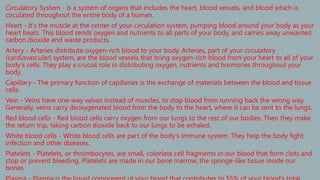Presentation1.pptx
- 1. Circulatory System - is a system of organs that includes the heart, blood vessels, and blood which is circulated throughout the entire body of a human. Heart - It's the muscle at the center of your circulation system, pumping blood around your body as your heart beats. This blood sends oxygen and nutrients to all parts of your body, and carries away unwanted carbon dioxide and waste products. Artery - Arteries distribute oxygen-rich blood to your body. Arteries, part of your circulatory (cardiovascular) system, are the blood vessels that bring oxygen-rich blood from your heart to all of your body's cells. They play a crucial role in distributing oxygen, nutrients and hormones throughout your body. Capillary - The primary function of capillaries is the exchange of materials between the blood and tissue cells. Vein - Veins have one-way valves instead of muscles, to stop blood from running back the wrong way. Generally, veins carry deoxygenated blood from the body to the heart, where it can be sent to the lungs. Red blood cells - Red blood cells carry oxygen from our lungs to the rest of our bodies. Then they make the return trip, taking carbon dioxide back to our lungs to be exhaled. White blood cells - White blood cells are part of the body's immune system. They help the body fight infection and other diseases. Platelets - Platelets, or thrombocytes, are small, colorless cell fragments in our blood that form clots and stop or prevent bleeding. Platelets are made in our bone marrow, the sponge-like tissue inside our bones.
- 4. âĒ Activity 2: Pump It Up In this activity, you will be creating the heart model to describe how the heart pumps blood. Materials Needed: ï· 1 small jar ï· 1 balloon ï· 2 pieces flexible drinking straws ï· Tape or glue ï· 1 pair of scissors ï· 1 large pan ï· Water, toothpick âĒ Procedures: 1. Fill the jar half full of water. 2. Cut the neck of the balloon off at the part where it starts to widen into a balloon. Set the neck part aside. 3. Stretch the balloon over the opening of the jar, pulling it down as tightly as you can. The flatter you can get the surface of the balloon, the better. 4. Get a sharp toothpick and gently poke two small holes on the surface of the balloon. Make them about an inch apart from each other and near opposite edges of the jar. 5. Get your straws and push one through each hole with the bendy part sticking out of the top. The straws should fit securely in the holes so that no air can get through around the straws. 6. šÝšÝßĢ the uncut end of the balloon neck onto one of the straws and tape it around the straw. 7. Set your pump in a large pan or the sink to catch the pumped water. Bend the straws downward. Gently press in the center of the stretched balloon and watch what happens to the water in the jar.
- 5. Guide Questions: 1. What does the water inside the jar represent? __________________________________________________________________________ __________________________________________________________________________ 2. What happens to the water inside the jar as you press the center of the stretched balloon? __________________________________________________________________________ __________________________________________________________________________ 3. How is heart pump model similar to the human heart? __________________________________________________________________________ __________________________________________________________________________ 4. Is it important for the human heart to pump? Why? __________________




